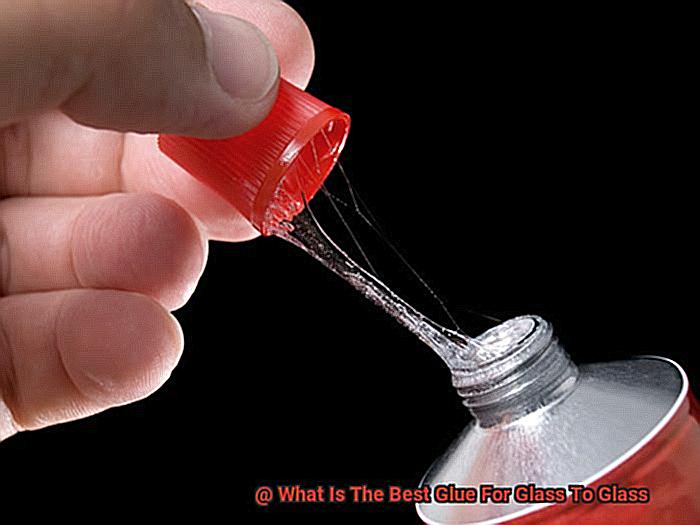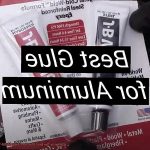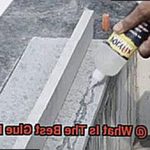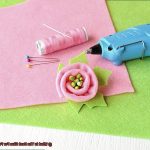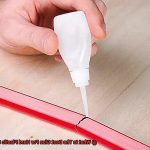Glass, oh how I love its beauty and versatility.
But let’s be real, when it comes to sticking two glass pieces together, finding the perfect glue can be a real pain in the you-know-what. Whether you’re tackling a crafty DIY project or desperately trying to fix that precious glass item you accidentally broke (oops.
), the glue you choose is crucial. You need something that’s not only crazy strong and durable but also specifically designed for gluing glass to glass.
Lucky for you, my friend, there are a few glues out there that truly shine in this department. In this blog post, we’re gonna dive deep into the best glue for glass-to-glass bonding.
We’ll chat about their awesome features, amazing benefits, and why they’re the top choices for all you glass bonding enthusiasts out there. So if you’ve got a glass project on your mind, keep reading ’cause we’re about to uncover the adhesive that’ll make your glass-to-glass bond practically unbreakable.

Trust me, it’s gonna be epic.
What is Glass-to-Glass Bonding?
Contents
- 1 What is Glass-to-Glass Bonding?
- 2 Factors to Consider When Choosing the Best Glue for Glass-to-Glass Bonding
- 3 Epoxy Resin: A Popular Choice for Glass-to-Glass Bonding
- 4 UV-Curing Adhesive: Fast Curing Times for Industrial Applications
- 5 Silicone Adhesives: Flexible and Durable Bonds
- 6 Proper Surface Preparation is Essential for Strong Bonding
- 7 How to Apply the Adhesive Correctly
- 8 Allow Adhesive to Cure Fully
- 9 Conclusion
Glass-to-glass bonding is a specialized technique used in various industries to join two glass surfaces together. It involves selecting the right adhesive, preparing the surfaces properly, and applying the adhesive correctly.
When it comes to choosing the right adhesive, there are several options available. UV-curing adhesives are popular for their fast curing time using ultraviolet light and excellent optical clarity. They are ideal for applications where aesthetics matter, such as electronics or medical devices. Epoxy-based adhesives offer exceptional strength, durability, and thermal stability. They are suitable for demanding applications like structural glazing or architectural designs. Cyanoacrylate adhesives, also known as super glue, bond rapidly but may not be ideal for long-term or outdoor use.
Proper surface preparation is crucial for successful glass-to-glass bonding. Thoroughly cleaning and degreasing the surfaces is essential to remove any dirt or contaminants that could hinder adhesive performance. Abrading the surfaces or using a primer can create a rougher surface for the adhesive to grip onto, enhancing bond strength.
When applying the adhesive, it is important to choose one that suits your specific requirements, such as temperature resistance or compatibility with other materials. The adhesive should be applied evenly according to the manufacturer’s instructions. Carefully align the glass pieces and firmly press them together, applying even pressure across the entire bond area. Clamps or tape can be used to hold the pieces in place while the adhesive cures. Allow the adhesive to cure fully without stress or movement.
Factors to Consider When Choosing the Best Glue for Glass-to-Glass Bonding
Choosing the best glue for glass-to-glass bonding requires careful consideration of several factors. It’s like finding the perfect partner – you want a glue that will create a strong and lasting bond. Here are the key factors to consider when choosing the best glue for glass-to-glass bonding:
- Strength and Durability: The glue should be able to withstand the stress and strain placed on the glass, ensuring a strong bond over time. Look for glues specifically designed for glass bonding, as they are often formulated to provide exceptional strength and durability.
- Transparency: Glass is transparent, so you want a glue that dries clear and leaves no visible residue. This ensures that the bond remains discreet and does not affect the overall appearance of the glass. Opt for glues that offer crystal-clear clarity.
- Chemical Compatibility: Choose a glue that is compatible with the type of glass being used. Some glues may react with certain types of glass, leading to discoloration or damage. Look for glues specifically designed for glass-to-glass bonding and check their chemical compatibility with your glass.
- Application Method: Consider the size and complexity of your project when choosing an application method. Glues come in squeeze bottles, syringes, or brush-on applicators, offering flexibility in how they are applied. Choose an application method that allows for precise and easy application, ensuring an even coverage and a strong bond.
- Drying Time: Consider the drying time of the glue for efficiency and convenience. Quick-drying glues offer faster bonding times, while others may require more time to fully cure. Choose a glue with a drying time that allows enough time for adjustments or repositioning before it sets.
- Temperature Resistance: If your glass-to-glass bond will be exposed to varying temperature conditions, choose a glue with good temperature resistance. This will ensure that the bond remains strong and stable even in outdoor or high-temperature environments.
- Flexibility: Glass can expand and contract with temperature changes. To accommodate this movement, choose a glue that offers flexibility. A flexible glue allows the glass to move slightly without compromising the bond, reducing the risk of cracks or breakage.
Epoxy Resin: A Popular Choice for Glass-to-Glass Bonding
Epoxy resin is a superhero among adhesives when it comes to bonding glass to glass. Its exceptional strength and durability make it the go-to choice for applications requiring a strong bond. But what sets epoxy resin apart and makes it so popular?
One of the key advantages of epoxy resin is its versatility in bonding different types of glass together. Whether you’re working with clear, colored, or textured glass, epoxy resin has got you covered. It can even bond glass to other materials like metal or plastic, making it a versatile adhesive for a variety of applications.
In addition to its versatility, epoxy resin also delivers on aesthetics. It creates a clear and transparent bond, ensuring that your glass project looks sleek and professional.
But epoxy resin’s popularity doesn’t end at looks – it’s built to withstand tough conditions. Resistant to water, chemicals, and temperature variations, this adhesive ensures that your bond will remain strong even in challenging environments.
Curing time is another factor to consider when using epoxy resin. Depending on the specific product used, epoxy resin can take several hours to fully harden. This gives you ample time to position your glass pieces perfectly before the adhesive sets.
Once cured, the bond created by epoxy resin is permanent and difficult to break. Your glass pieces will stay securely bonded together for years to come.
It’s important to handle epoxy resin with care due to its messy nature. Protective measures like gloves and proper ventilation should be used to ensure safety during application. Additionally, surfaces should be thoroughly cleaned before applying the adhesive for an extra-strong bond.
UV-Curing Adhesive: Fast Curing Times for Industrial Applications
In the realm of industrial bonding, every second counts. That’s why manufacturers and engineers are embracing the power of UV-curing adhesive for their glass-to-glass bonding requirements. With its exceptional speed and strength, UV-curing adhesive has emerged as the superhero of adhesives in industrial applications.
Lightning-Fast Curing Time:
Say goodbye to waiting hours or days for adhesives to cure. UV-curing adhesive boasts an incredible ability to achieve full bond strength in a matter of seconds. This lightning-fast curing time translates into increased production rates and ensures efficiency in time-sensitive industrial settings.
Versatile Bonding Capability:
UV-curing adhesive possesses the power to bond a wide range of materials, including glass. Whether it’s clear, colored, or textured glass, this adhesive can handle it all. Furthermore, it can forge strong bonds between glass and other materials like metal or plastic. This versatility makes it the adhesive of choice for various industrial applications.
Exceptional Bond Strength:
When it comes to bonding glass to glass, UV-curing adhesive reigns supreme. Its formidable bond strength withstands temperature changes, moisture, and exposure to chemicals—guaranteeing that the bonds created will endure even the harshest industrial environments.
Environmental Benefits:
UV-curing adhesive is a solvent-free solution, eliminating the release of harmful volatile organic compounds (VOCs) during the curing process. This not only ensures a safer working environment for employees but also contributes to a greener future. By choosing UV-curing adhesive, manufacturers can align their practices with sustainable values.
Precise and Controlled Application:
UV-curing adhesive allows manufacturers to exercise precise control over the application process. Applied in liquid form, it cures quickly when exposed to UV light. This level of control ensures uniform bond quality, eliminates the risk of adhesive drips or uneven distribution, and enhances overall efficiency.
Silicone Adhesives: Flexible and Durable Bonds
Are you tired of your glass pieces falling apart? Looking for a reliable adhesive for your glass projects? Look no further. Silicone adhesives are here to save the day. These flexible and durable adhesives offer a range of benefits that make them the perfect choice for bonding glass to glass.
Silicone adhesives, made from silicone polymers, possess unique properties that set them apart. First and foremost, their flexibility is unmatched. Withstanding a wide range of temperatures without losing bond strength, silicone adhesives are suitable for both indoor and outdoor applications. Whether you’re working on a beautiful stained glass window or creating a stunning glass sculpture for your garden, silicone adhesives will hold it all together.
But flexibility isn’t the only advantage. Silicone adhesives provide excellent resistance to moisture, UV radiation, and chemicals. This makes them perfect for areas where glass is exposed to water or harsh conditions, like bathrooms or kitchens. Say goodbye to worries about adhesive deterioration or losing grip over time.
To achieve a strong and long-lasting bond between glass pieces, proper surface preparation is essential. Cleanliness is key. Thoroughly clean the surfaces, removing any dust, oil, or contaminants that could hinder adhesive effectiveness. This ensures optimal results.
Silicone adhesives come in various forms – sealants, caulk, gels – depending on the application and desired level of flexibility. Selecting a high-quality silicone adhesive specifically designed for glass-to-glass bonding is crucial for optimal results.
Following the manufacturer’s instructions for application and curing times guarantees maximum strength and effectiveness. This ensures the adhesive properly bonds the glass surfaces, withstanding stress and movement without cracking or peeling.
Proper Surface Preparation is Essential for Strong Bonding
I’m here to spill the beans on the secret to achieving a strong bond between glass surfaces – proper surface preparation. It’s the key to creating a durable and long-lasting bond that will stand the test of time. So grab your cup of coffee and let’s dive into the details.

Cleanliness is crucial. Before applying any adhesive, make sure those glass surfaces are sparkling clean. Use a mild detergent or glass cleaner to wipe away any dirt, dust, or oils lurking on the surface. And don’t forget to use a lint-free cloth for an extra shine.
Now, let’s get interesting – roughening those glass surfaces. This step might sound counterintuitive, but trust me, it works wonders for adhesion strength. Lightly sanding the surfaces with fine-grit sandpaper or using a glass etching solution creates a slightly roughened surface. This provides more area for the adhesive to grip onto, giving your glue something to hold onto for dear life.
But we’re not done yet. After roughening the surfaces, it’s crucial to remove any residue or dust resulting from the sanding or etching process. Thoroughly rinse the glass surfaces with water and let them dry completely. We want a clean canvas for our adhesive masterpiece.
Alignment matters too. Make sure those glass surfaces are properly aligned and supported during bonding. Uneven or misaligned surfaces can lead to uneven stress distribution on the adhesive, compromising its strength and durability. Take your time and get those pieces perfectly lined up.
- And here’s a pro tip – read the instructions. Different adhesives have different requirements for surface preparation. Some may require extensive cleaning and roughening, while others may need specific primers or activators. Follow the instructions provided by the adhesive manufacturer. They know their stuff.
- So there you have it, my glue-loving friends – the secret to achieving a strong bond between glass surfaces lies in proper surface preparation. It’s all about cleanliness, roughening, alignment, and following those manufacturer’s instructions. Take the time to prepare your surfaces correctly, and you’ll be rewarded with a bond that will withstand the test of time.
How to Apply the Adhesive Correctly
To achieve a strong and durable bond when gluing glass to glass, it is essential to use the right adhesive and apply it correctly. In this comprehensive guide, we will walk you through the step-by-step process of how to apply adhesive correctly for glass-to-glass bonding.
Clean the surfaces:
Start by meticulously cleaning the glass surfaces using a mild detergent or glass cleaner. This step is vital to eliminate any dirt, dust, or oil that can compromise the bonding process. Ensure the surfaces are completely dry before proceeding.
Apply adhesive evenly:

Using a small brush or applicator, apply a thin, even layer of adhesive onto one of the glass surfaces. Be cautious not to use an excessive amount of glue, as it can seep out from the edges and create a messy appearance. Generally, a thin layer is sufficient for most projects.
Join the surfaces:
Align the second glass surface carefully with the one already coated with adhesive. Press them firmly together, ensuring proper alignment. Apply gentle pressure for a few minutes to allow the adhesive to bond effectively. To hold the glass pieces in place while the glue sets, you can utilize clamps or heavy objects.
Allow curing time:
Follow the instructions provided by the adhesive manufacturer regarding drying and curing times. It is crucial to allow sufficient time for the adhesive to fully set before handling or moving the bonded glass pieces.
Check for gaps and clean up:
Once the adhesive has dried and cured, inspect for any gaps or areas that may require additional glue. Apply a small amount of adhesive to fill in any gaps and ensure a strong bond between the glass pieces. Promptly clean up any excess glue using a damp cloth or cotton swab.
Allow Adhesive to Cure Fully
Today, we embark on a journey through the captivating world of adhesive curing. If you’ve ever pondered the importance of allowing adhesive to cure fully, you’re in for a treat. Join us as we delve into the virtues of patience, explore the factors that influence curing time, and uncover the steps to achieve optimal bond strength and durability.
The Power of Curing:
Curing is a remarkable metamorphosis where an adhesive transitions from a liquid or semi-solid state into a resilient and tenacious bond. Picture a caterpillar transforming into a breathtaking butterfly. But why is this process so crucial? Well, my dear readers, allowing adhesive to cure fully is the key to unlocking an unbreakable connection between glass surfaces.
Factors Affecting Curing Time:
Now, let’s explore the factors that can influence the curing time. Adhesive type, temperature, humidity, and even the thickness of the adhesive layer all play a role. Each adhesive has its own preferences for optimal curing conditions. Remember to consult the manufacturer’s instructions for specific guidance tailored to your chosen adhesive.
The Virtue of Patience:
Patience – a virtue that holds tremendous sway during the curing process. Resist any temptation to rush or subject your bonded glass surfaces to stress prematurely. Great things take time, much like fine wine reaching its peak or a tantalizingly slow-cooked meal. So sit back, relax, and let that adhesive work its enchantment.
Testing for Full Cure:
Once you’ve allowed ample time for the adhesive to cure fully, it’s time for a test. Apply gentle pressure or employ specialized equipment for a pull-off test to ensure your bond is ready for action. This step is pivotal in guaranteeing the strength and durability of your connection.
Post-Curing Care:
Congratulations. Your adhesive has completed its journey to full cure, resulting in a bond that is now an unstoppable force. However, it is crucial to handle your bonded glass surfaces with caution. Steer clear of exposing them to extreme temperatures or harsh chemicals to preserve the bond’s integrity over time.
pGide3gzWWo” >
Also Read: How to Glue Plexiglass to Glass?
Conclusion
In conclusion, there are several outstanding options available when it comes to gluing glass to glass. Epoxy resin, UV-curing adhesive, and silicone adhesives all stand out as popular choices for creating a bond that is both strong and durable.
Epoxy resin is renowned for its exceptional strength and incredible versatility. It has the ability to bond different types of glass together and can even adhere glass to other materials like metal or plastic. With its clear and transparent finish, epoxy resin ensures that your glass project looks sleek and professional. Not only that, but it also boasts resistance to water, chemicals, and temperature variations, making it suitable for both indoor and outdoor applications.
For lightning-fast results in industrial settings, UV-curing adhesive is the go-to choice. This adhesive can achieve full bond strength in a matter of seconds, increasing production rates and ensuring efficiency in time-sensitive environments. It offers exceptional bond strength that can withstand temperature changes, moisture, and exposure to chemicals.
When it comes to flexibility and durability, silicone adhesives take the spotlight. They are capable of withstanding a wide range of temperatures without losing bond strength, making them perfect for both indoor and outdoor applications. Additionally, silicone adhesives offer excellent resistance to moisture, UV radiation, and chemicals.
To achieve a strong bond between glass surfaces, proper surface preparation is crucial. Thoroughly cleaning the surfaces and roughening them create an optimal surface for the adhesive to grip onto. And don’t forget about proper alignment during bonding – this step is vital for distributing stress evenly across the adhesive.
Last but not least, allowing the adhesive to cure fully is essential for optimal bond strength and durability. Each adhesive has specific curing requirements that should be followed carefully.
By considering these factors and selecting the right glue for your specific needs, you can embark on your glass bonding journey with confidence – knowing that you will achieve a strong and long-lasting bond when gluing glass to glass.

